European Gaming Emissions, and how we address them
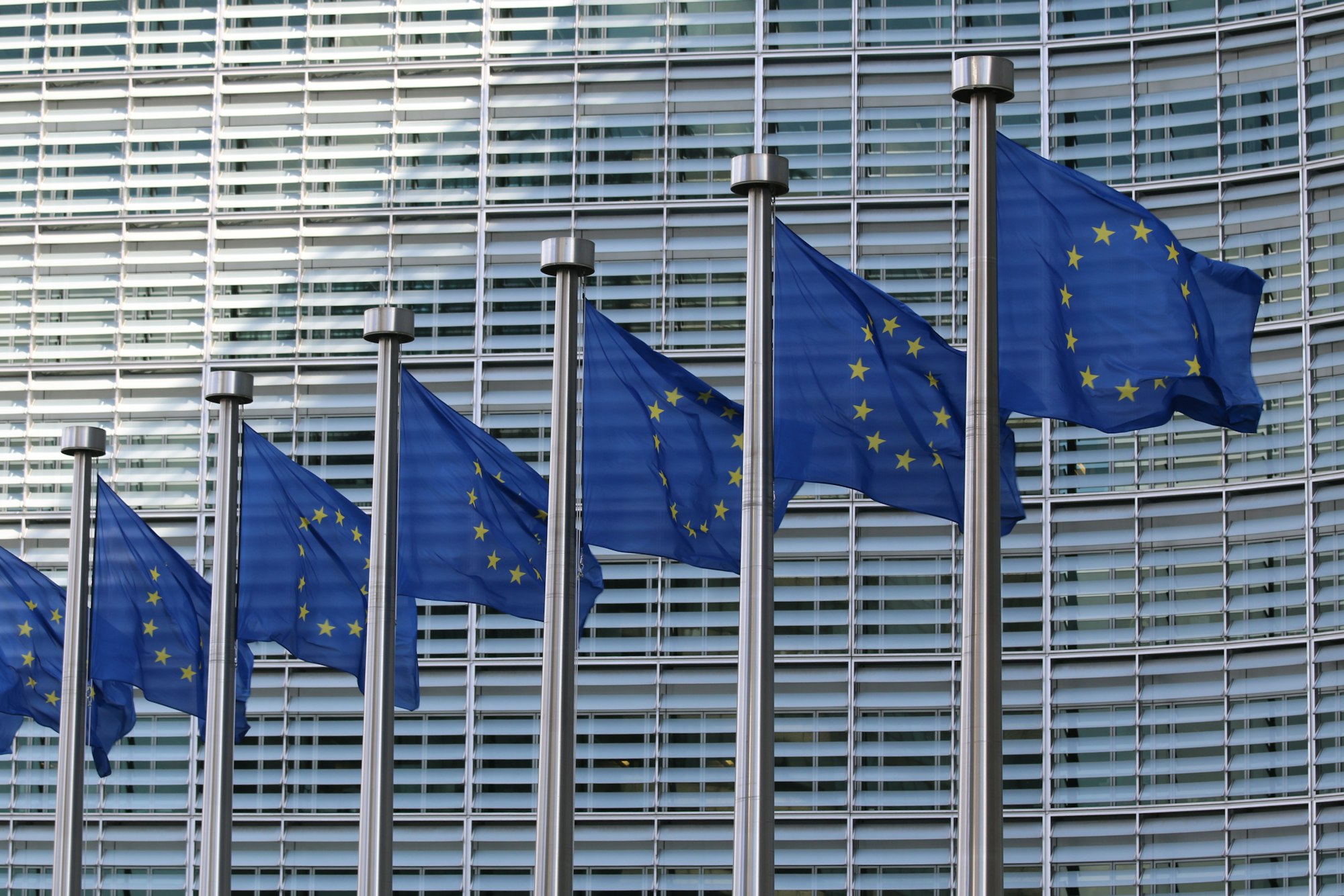
I was asked earlier this week by Joost Raessens (Utrecht University Professor, and coordinator of STRATEGIES: Sustainable Transition for Europe’s Game Industries a major Horizon-funded research project just kicking off) about whether there were any solid figures for the scale of the footprint of the European games industry. I admit, I have not greatly emphasised breaking down emissions by region, and as far as I am aware there’s still no one else besides me actively tracking these types of figures. The only ones who might be are Sony (though if they are, they are not sharing them), and in the next 12-18 months the EU is likely to have the capacity to, given the data they will be collecting in the rapidly approaching new CSR directive.
So I had a bit of a think about what data I do have, and ways we might make some plausible, informed estimates. Strap yourself in, because this is a deep dive.
The data and numbers in my annual Net Zero Snapshot encompass the biggest companies in the global games industry, and it's rare to get regional breakdowns with sufficient detail to extrapolate from. There are only 7 companies (out of about 38 that I’m now collecting from) headquartered in Europe, the biggest two of which (Embracer & Ubisoft) are some of the most internationally distributed companies in the entire snapshot. So that makes things tricky.
There are, however, a few studies that have looked specifically at European components of the global picture. For instance, Joshua Aslan’s (2020) foundational and richly detailed PhD thesis looked at the distribution of PS4 discs across Europe, estimating a climate cost of 270g of CO2e per disc. Sony’s global manufacturing plant is in Thalgau, Austria, minimising the transport miles for European sales – in Australia and other further flung parts of the world, that figure will balloon substantially. But it provides just enough detail to extrapolate for Europe.
We know the approximate number of PS4 games sold globally was 1.42 billion (!!) but a substantial portion of those were digital sales via the PlayStation online store. VGChartz – a good source for most game sales figures – doesn’t break down platform software sales totals by region, unfortunately. The ‘tie-ratio’ however suggests the amount of software sold for each console, which we can combine with regional hardware sales numbers to make some rough estimates. Here’s a table of estimates produced that way for European game software sales.
| Console | EU hardware sales (m) | Console tie ratio | EU software sales (m) |
|---|---|---|---|
| PS4 | 45.85 | 12.12 | 555 |
| PS5 | 17.38 | no data | – |
| XB1 | 14.86 | no data | – |
| XBS/X | 7.34 | no data | – |
| Switch | 35.06 | 8.32 | 291.7 |
Not having any tie ratios for Microsoft platforms (or even the PS5) is a shame, and since I'm not aware of any lifecycle studies of Switch cartridges (which are quite different to discs) PS4 disc sales are all we can estimate consequent emissions from these sales. But how many of those sales were discs vs downloads? In Digital Games After Climate Change I cited a Daniel Ahmad tweet that suggested 2020 was the first year that digital sales beat physical disc copies of PS4 games for the first time. For 2013-2020 then, physical sales were at least >50% of software sales. To be conservative, let's assume half of 555m sales were discs, at 270g CO2e each, for somewhere between 75,000 and 150,000 tons of CO2e seems plausible to me. That’s a fair chunk of emissions just for making PS4 discs and sending them to shops across Europe. On top of that, there will have been Xbox and Switch discs and cartridges, plus the effects of plastic ending up in landfill, or getting incinerated.
Aslan’s (2020: 204) study also looked at the difference in digital download vs physical disc purchases for an average download size of 40GB (small by today's standards) and the “average” play duration, which was 214 hours. If that seems high, consider the number of long-tail GaaS players, with hundreds, even thousands of hours played. With these variables, downloaded PS4 games in Europe were the lowest in impact. Both the greater distance that discs will travel when sent outside of Europe and the often higher grid emissions per kWh in other parts of the world mean that care would need to be taken in estimating for anywhere else. Plus, much has changed since 2019 when the study was conducted. Still, it's a useful starting place.
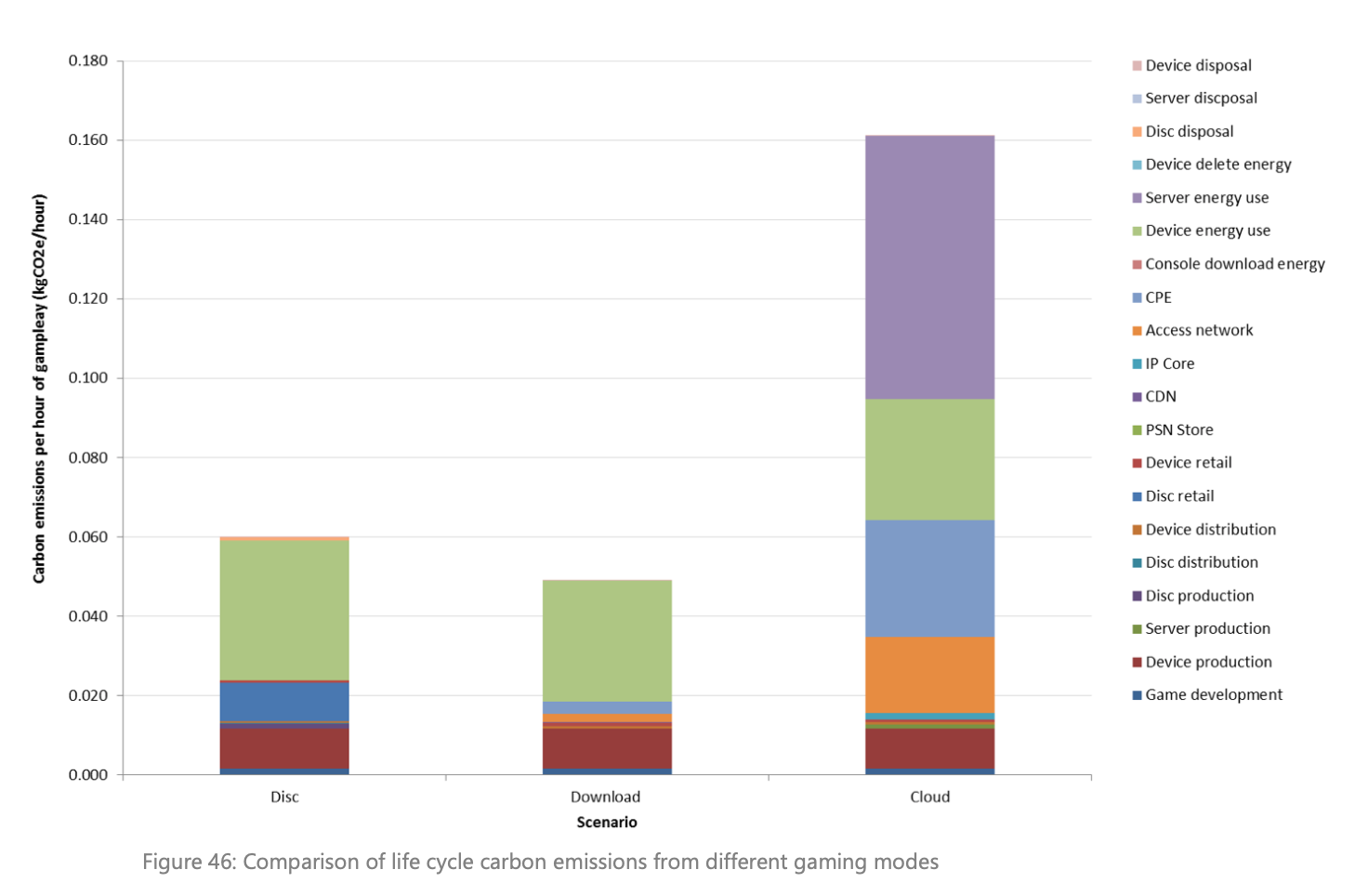
Aslan's (2020: 211) analysis also notes that the “total length of time a game is played for is the most important variable in terms of affecting the carbon emissions per hour of game-play.” As play duration approaches 1000 hours, the difference between disc and download approaches zero, as the use-phase energy consumption of the console overshadows the distribution component. In such cases though, cloud gaming emissions remain quite high due to greater total energy consumption from servers and networks. Aslan's study was not able to consider the effect of 100% renewable-powered data centres, however.
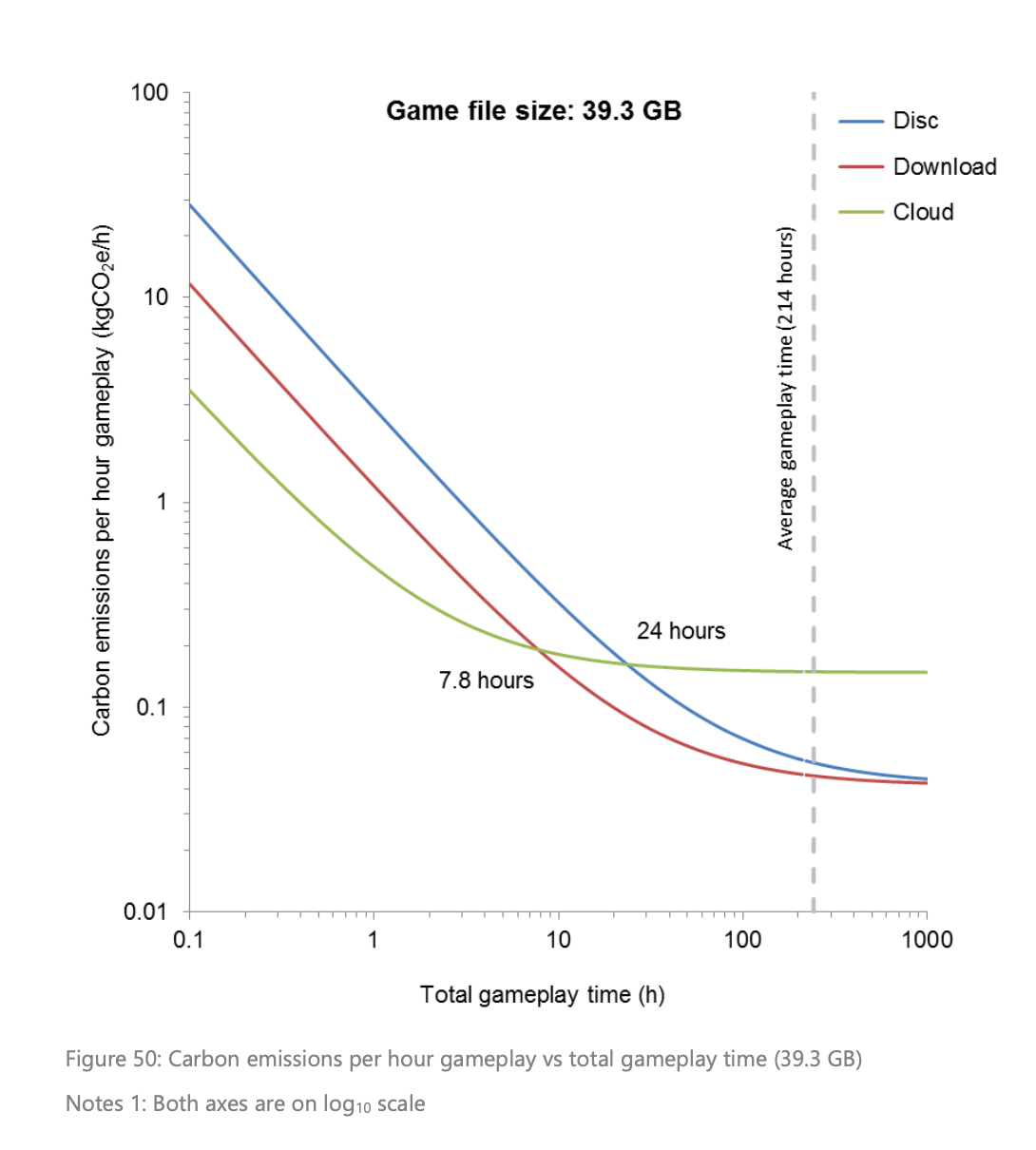
Aslan’s PhD study also estimated the total power consumed by the entire European install base of PS4 consoles from launch to approximately 2019, along with the consequent CO2 emissions. This involved some complex modelling of different PS4 hardware sales figures and measured reductions in consumption across SKUs. This allowed the modelling of efficiency improvements over the years the console was made and sold, bringing down electricity consumption by a rather staggering amount: he finds an estimated "6 to 8 TWh of avoided electricity consumption has been achieved." (Aslan 2020: vii) And all that just through efficiency improvements in one console – clearly an important area to target. Aslan’s (2020: 260) emissions estimates for the PS4’s European lifetime emissions conclude that:
the 30 million PS4 consoles sold in Europe to [circa 2019] are estimated to produce approximately one million tonnes of carbon equivalent emissions per year, approximately 0.025% of the annual emissions produced by the EU-28 in 2015 (European Environment Agency, 2018).
Unfortunately, we are now well past the PS4 era, and as yet no one to my knowledge has updated Aslan’s figures for the PS5/XBS era. Given these new consoles have substantially higher energy consumption, with the most efficient PS4 model using as little as 75 Watts, and given that the most recent PS5 Slim still uses roughly the same 220+ Watts as the launch PS5 (as discussed here in this recent post) this suggests to me these figures are highly like to be growing. This is bad news for Europe, as the European energy grid’s CO2 intensity has reversed its downward trend pre-2021.
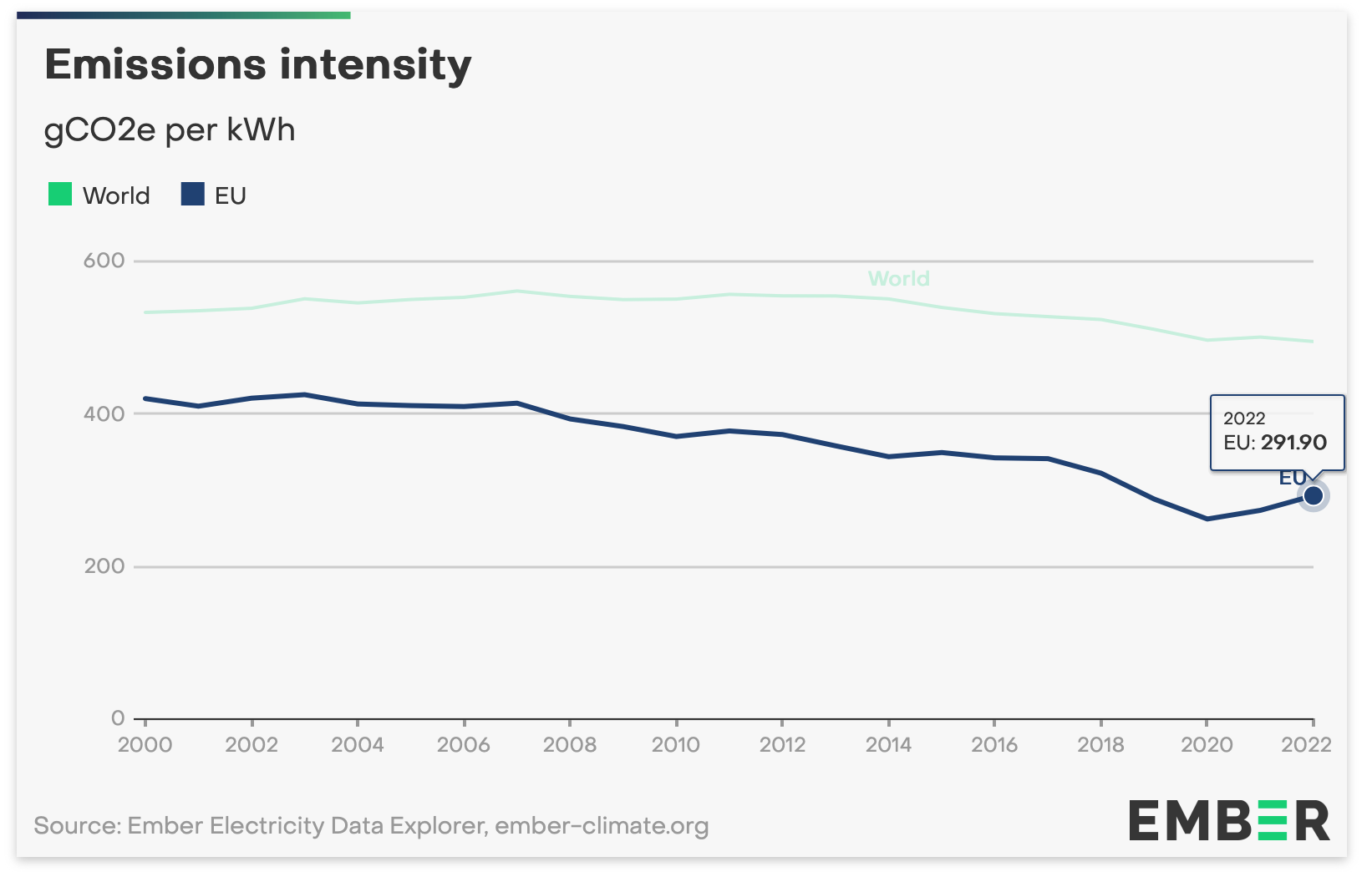
It’s a double whammy of using more power than previous generation consoles, while that power has also become more dirty than it was pre-2021. This should be deeply concerning to the entire European games industry, and weight on the conscience of hardware platform owners' (looking at you Sony and Microsoft), and above all, be concerning to European Union decision-makers.
If European PS4 (and now 5) gamers are increasing emissions, it's also happening at a time when the EU's overall emissions have been dropping, from 3.09 billion tCO2e in 2015 to 2.76 billion tCO2e in 2022. If end-user PlayStation 4 (and now 5) emissions even stayed the same at around 1 million tCO2e per year, then that 0.025% figure will have grown as a percentage to 0.036% of the total EU-27 footprint (Brexit complicates this a touch – but the UK has a lower per kWh CO2 intensity than the EU average!). I shudder to think what that figure has been doing for PC hardware.

So that’s European discs, and gameplay (downloads I haven’t even touched yet – we really need Valve to report something). That just leaves everything upstream of the game being sold. Specifically, hardware and software development emissions.
Most game hardware manufacturing happens outside of Europe, but leaving this off the books entirely ends up absolving rich Western consumers and their governments of responsibility, shifting it to poorer developing countries. Thanks to increasing corporate product disclosures, we do have quite a bit of detail about the embedded emissions from manufacturing consoles.
Aslan’s (2020) study again found for that each PS4 manufactured, slightly over 50kg CO2e was emitted, and thanks to Microsoft’s environmental product data sheets, we can see that the Xbox One devices involved emissions of around 149kg CO2e per XB1. Microsoft has also kindly published similar data sheets already for the Xbox Series consoles (111kg/190kg for the Series S/X respectively) but I haven’t been able to find any LCAs for the PS5 so far. I struggle to imagine the PS5 keeping under the PS4 per-unit manufacturing emissions figure, given the added size and performance (I would not be shocked if it were double, in fact) but in the absence of any actual data let’s reuse that figure.
Here’s another table of the results. I have sourced European sales figures from the same VGChartz regional hardware platform totals again.
| Console | Unit emissions (kg CO2e) | European sales (m) | Total (m tCO2e) |
|---|---|---|---|
| PS4 | 50 | 45.85 | 2.29 |
| PS5 | 50+ ?? | 17.38 | 0.9 |
| XB1 | 149 | 14.86 | 2.22 |
| XBS/X | 111/190 | 7.34 | 1.4 |
| Switch | no data | 35.06 | – |
| TOTAL | 85.43 | 6.81 |
So 6.81 million tonnes of CO2e from manufacturing consoles were sold in the EU, across just two main console brands, and only the last two console generations. While these emissions occur outside the EU – in China or Taiwan – those emissions enter the same atmosphere we all share. Responsibility or ownership of them is, at the very least, shared with the country where the product is sold. No demand for product, no emissions after all.
What’s going on with Nintendo? I have no idea. Nintendo doesn’t appear to conduct (or at least, disclose) any lifecycle impact for their products. The closest I have come to finding one is this student project from 2019, but it only touches on the materials and resources consumed by the manufacturing process. We might be inclined towards a lower per-unit figure since the Switch uses older hardware, and is a smaller and cheaper console, with a lower materials bill. But potentially counting against that is that it also includes a lithium-ion battery the other consoles do not. But I’m just speculating now. We need LCAs for all game hardware.
Lastly, game development activity in Europe. What do we know about it? The AfterClimate Net Zero Snapshot tallied up disclosures of between 7 and 14 million tCO2e (the higher end including projections from some of the non-reporting companies extrapolated from industry averages). This range includes just the most “pure play” companies. If you do include the big tech companies (Microsoft, Sony, Apple, Google, Tencent) at the risk of including an unknown (but large) chunk of non-gaming emissions, that tally rises to 80m tCO2e disclosed for the 2022 calendar year.
The Net Zero Snapshot exercise also produced the first industry-wide per-employee CO2e figures. Taking pure-play company averages might be a way to extrapolate to Europe if we know how many developers work in games on the continent. Luckily, Joost linked me to this PDF report from Videogames Europe, which came out mid-last year and puts a figure of 110,000 people working in games across Europe in 2022.
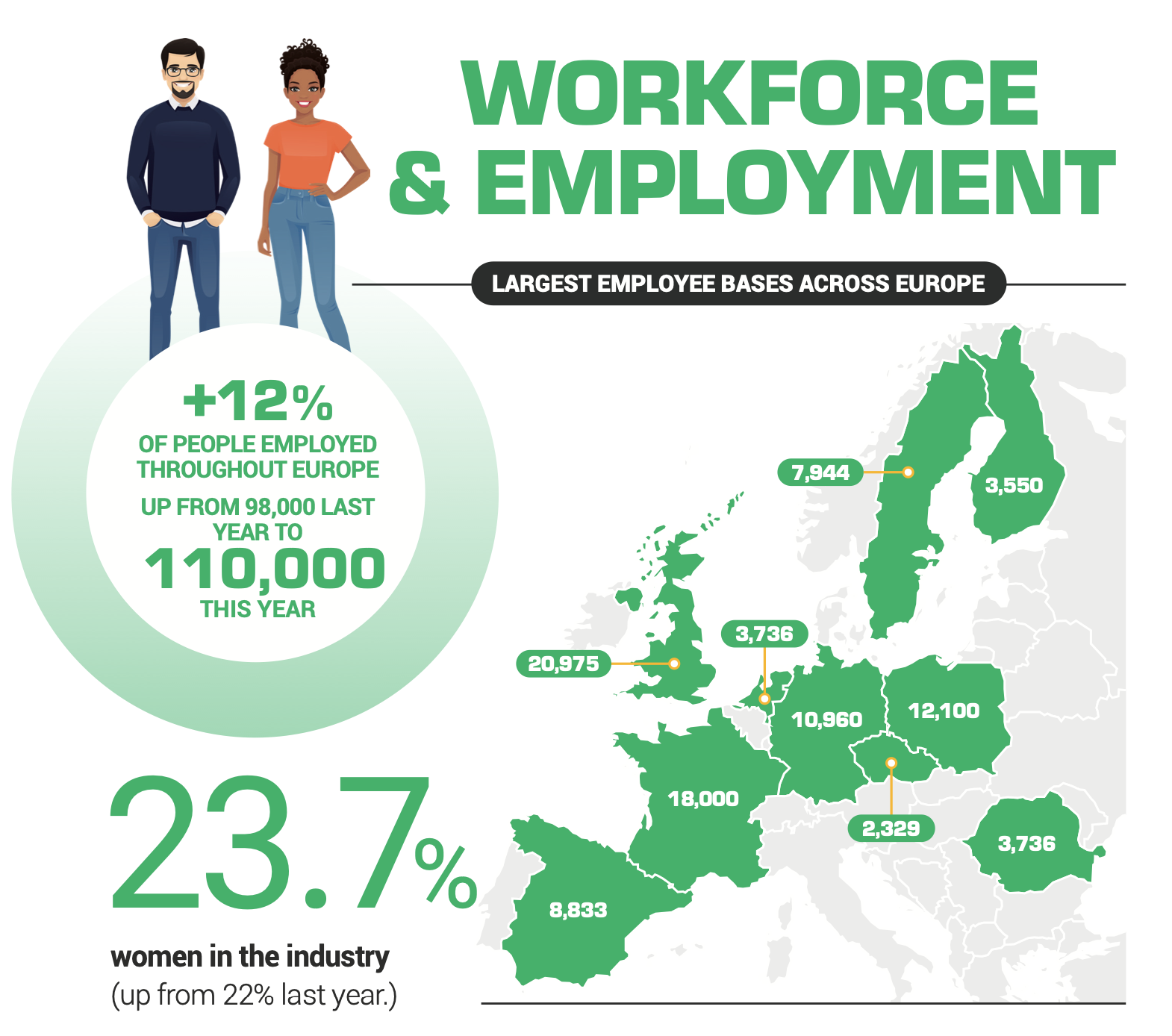
I imagine this figure was from before the current rounds of layoffs, but we can combine this with the per-employee intensity figures from the Snapshot (which conveniently is all 2022 data) for an estimate of the year's emissions. Here’s my table showing these calculations:
| Euro employees | Scope 1 + 2 per employee avg | Scope 1 + 2 + 3 per employee avg |
|---|---|---|
| 110,000 | 2.16 | 72.46 |
| TOTAL | 237,600 tCO2e | 7,970,600 tCO2e |
I’ve provided a Scope 1 + 2 per employee estimate, as well as a Scope 1 + 2 + 3 per employee estimate. The reasoning for this is that Scope 1 + 2 are nice and easy to calculate and disclose, anyone can do it and pretty much get it right (though not always). Scope 3 however, as I show clearly in the Games Industry Sustainability Benchmark, is basically a Wild West. Almost anything goes in terms of what companies can leave in or out. This is because under the GHG Protocol Scope 3 is an entirely optional category. Nothing has to be in Scope 3 – and as a result, plenty of companies make their own decisions about what to include and leave out, or even leave out Scope 3 entirely.
This situation is unacceptable, penalising the ambitious, who calculate emissions diligently and comprehensively, and rewarding the negligent who overlook major sources of harm to the planet or shift responsibility for it onto others (be it platform owners, consumers, governments – take your pick!).
Take the example of Scope 3, Category 11 “Use of sold products” – which is where the estimated emissions of the gamers playing the games that companies make should appear. In the GISB I showed exactly who is willing to tally up the impact of gamers playing their games and who is not. The argument against it appearing in game developers’ Scope 3 footprint is that “it's the hardware designers and manufacturers who determine the power consumption of consoles” and I agree. To a point. We have seen (in no small part thanks to the efforts of one of those hardware makers) that it is possible to reduce the impact of gaming software.
But the real reason it needs inclusion, to my mind, becomes clear when we ask who has the best access to the data? Who can get the figures necessary to calculate those gamer's footprints? Taking it a step further we should also ask who has control over game software itself? Who can build in the metrics, tracking, automation and estimates, as well as teh FPS and resolution caps in menus, and whatever else we might think up, and reduce the scale of gamer's footprint? It’s not Microsoft, Sony, and Nintendo that’s for sure. So why would we accept leaving this important category from our reporting? Who else could measure it more accurately? Who can act with more swiftness and decisiveness? Who will do it if the developers themselves won’t?
I think part of the reluctance to include Scope 3 Category 11 (i.e. gamers) in emissions disclosures stems from the mistaken notion that we can (or should) buy our way out of the climate crisis. That is 20th-century thinking, and it deserves to stay there. Expensive carbon credits are at their very best an imperfect stopgap on the way to permanent zero emissions production. At worst, they are a waste of money, or a smokescreen to avoid reductions by some of the worst companies on the planet. Kill the carbon credit inside your head! Say Yes to real emissions solutions through a shift to clean energy, clean production and consumption. We can no longer let our thinking be “business as usual + the cost of a ton of CO2”.
This should be a liberating realisation! There are sometimes cheaper, but always more effective ways to reduce emissions. Eventually, they all have to go to zero anyway or we’re stuffed. There are not enough trees to go around. A more fundamental shift is needed.
Returning to the question of the European gaming footprint, what is the final tally? Here are the results of all the calculations above, with a column for details on what’s included in each. Keep in mind, these are a mix of lifetime/cumulative emissions over several years (hardware manufacturing, distribution of discs) and annual figures (software development, end users) drawn from the slow churn of annual corporate disclosures.
| Prod. phase | Inclusions | EU footprint total (m tCO2e) |
|---|---|---|
| Hardware manufacturing | PS4/XB1/XBX/PS5 | 6.81 |
| Software development (partial) | Scope 1 + 2 avg. extrapolated | 0.238 |
| Software development (complete) | Scope 1+2+3 avg. extrapolated | 7.97 |
| Distribution | PS4 discs | 0.075-0.15 |
| Players | PS4 lifetime (to 2019) | 1 (per annum; circa 2019) |
| TOTAL | 14.855 +1 per annum approx (end users) |
These are my best estimates for the European gaming footprint then – and yes, it’s also important to note that given a diligent few companies include Scope 3 Category 11 (gamers!) in their corporate footprint, there will be a small amount of double counting, but there is far, far more being left out of this picture. There is no Nintendo, no Microsoft console players, and not a single gaming PC in this picture. Your guess is as good as mine how high their inclusion might push these figures.
Things are moving fast, and we are barely moving fast enough to keep up. A great acceleration has been underway for our entire lifetimes. The urgency of it keeps me awake some nights.
Next steps
Here’s where I recommend actions – concrete steps we can all take. Pressure legislators, buy renewables, sign power purchase agreements, buy heat pumps, etc. But rather than give a laundry list of things, I want to shift gears and talk about institutions.
Almost all of the challenges I have outlined are problems of collective action, requiring some sort of collective response. In liberal capitalist democracies, talking about collective responses means talking about institutions. The games industry, to address the endless circulation of responsibility, needs some new institutions. Luckily, others seem to agree – so this year we’re starting a cooperative for games businesses with real climate ambition. We are focusing on Europe, initially, as European companies now have to meet new reporting requirements under the CSRD, and we’re planning to help make that more straightforward.
We are also going to take a real good hard swing-for-the-fences type go at producing a standard for the videogame industry, solving some of these issues around responsibility, who can take what kinds of action, and speed up decarbonisation all up and down the value chain (i.e. those huge Scope 3 emissions). The cooperative is called the Sustainable Games Alliance (SGA), and it’s the brainchild of Maria and Jiri who you might remember from the YouTube series last year where they spent 10 weeks talking to European game makers about their plans and concerns around climate change. If you don’t have time to watch all the episodes, I found the final one and their concluding thoughts encouraging.
There are lots of people already working on games and sustainability in different ways, in different parts of the field. From the IGDA Climate SIG to the Playing 4 The Planet Alliance, to the JYROS group in France (who have already started work on French-specific product rules for calculating game emissions). There could be – and should be – even more.
Some things will set the SGA apart from these and other existing orgs and institutions, but I don’t want to outline the full vision for it just yet. But the SGA will be a not-for-profit, and the standard will be open for anyone and everyone in the games industry, making all our lives easier, our data more comparable, more equitable and reportable. But we can't do it by ourselves.
Is it necessary? Is it needed? Yes, I think so. Will it solve all the sustainability challenges facing the European games industry? Absolutely not. But I do think we stand a really good chance of accelerating the pace of change, and becoming a force multiplier, by getting a sufficiently large group of game businesses, trade orgs, other co-operatives and indie studios (maybe even individual devs too, who knows) all pulling together on the levers. If there are enough of us, my ambition is to reach outside the games industry and have real pull with major suppliers, and change expectations among gamers themselves, maybe even help governments to understand better how they can support this industry on the way to net zero. Hey maybe we'll even get to show hardware and platform owners there is demand for a completely new paradigm in development out there.
I’m finding it really scary already! But in a good way. Jiri, Maria, the rest of the team and I have been on a couple of calls over the past few weeks and months. We seem to all share the same sentiment – that we at least have to try. If it fails, at least we can say that we did what we could.
I’ve spent the past three years trying to push the global games industry to greater awareness, greater concern for its sustainability, and make it clear that there are solutions for the industry to reduce its impact. It’s come at a real cost, let me tell you! So I hope it doesn’t fail. I want us to succeed, and wildly so, beyond even our most ambitious vision. Because it's overdue.
I’ll have more soon about ways you can stay in touch with the SGA, and importantly how to get involved. But in the meantime, if you are involved in a mid-size to large-size games business operating in the EU, thinking about your long term sustainability strategy and EU reporting – then I you think you should think about being a part of this. Reach out to myself (you can always reply to this email), or to Maria or Jiri direclty and let's talk about it. There are millions of tons of European CO2e emissions to prevent! The window for action is closing.